For many of us we may learn to call a familiar amphibian by the name of toad or frog from a young age. While these labels in time become ingrained few people would be able to outline why one is a toad and one is a frog.
With frogs being the biggest group of amphibians in the world, it’s certainly worth knowing a little more about why we divide them into toads and frogs.
Physical Characteristics
Skin Texture
Frog skin (smooth and moist)
One of the most common ways that people choose to distinguish between frogs and toads is their skin. Frogs are usually said to have smooth and moist skin. Yet, despite this there are some frogs that have bumpy skin.

Also read: Evolution of Frog Skin: Do Frogs Have Scales?
Toad skin (dry and bumpy)
Toads on the other hand often have bumpy skin. These are usually referred to as warts, and many people will often state that toads have warty skin. However, despite the name, toad warts are not the same as the warts that humans can catch. Instead these warts are glands that exude toxins or other liquids onto the toad’s skin.
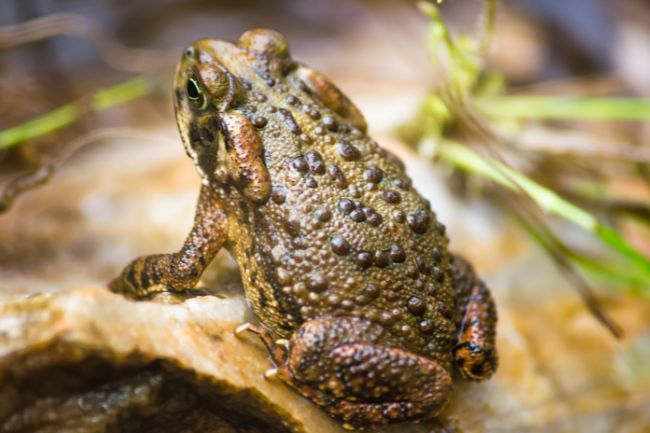
| Characteristic | Frogs | Toads |
|---|---|---|
| Skin Texture | Smooth and moist | Dry and bumpy |
| Body Shape | Slender and streamlined | Stockier and squat |
| Legs | Long, well-adapted for jumping and swimming | Shorter, more adapted for hopping |
| Webbing | Hind feet webbed, good swimmers | Little to no webbing, terrestrial |
| Parotoid Glands | Absent or small | Prominent, produce toxins |
Body Shape
Another way to differentiate between toads and frogs can be their body shape. Toads are often broader and squatter. This is because toads often have legs that are positioned slightly differently to a frog’s legs, meaning they are built for walking rather than for hopping.
A frog’s longer legs will allow them to jump much further, and usually give them a more elongated shape. Frogs are also said to have more protruding eyes, while a toad’s eyes may be more recessed into their heads.
Toads can also often be larger than frogs, with many of the largest species being labeled as toads, for example the cane toad. There are notable exceptions however, such as the pacman frog.
Also read: Frog Eyes Unveiled: Do Frogs Blink?
Habitat Preferences of Frogs and Toads
Both frogs and toads tend to prefer damper environments, such as in or near water. This is because their skin is very thin, and allows moisture to travel through it. This has its advantages, as they are able to drink through their skin, by sitting in puddles.
However, compared to frogs, toads have slightly thicker skin. This means they are more able to spend time away from water, as they are less at risk of losing water through evaporation. Many toads will spend long periods of time away from water, and return to pools and other wetlands during breeding periods.
Other than this both frogs and toads can be found across a range of habitats, from tropical forests to grasslands, even to deserts. It’s their adaptability that has made them so able to live and thrive in different habitats.
| Aspect | Frogs | Toads |
|---|---|---|
| Preferred Habitat | Moist environments like ponds, streams | Drier habitats like forests, gardens |
| Skin Moisture | Require constant moisture | Tolerate drier conditions |
| Mating Behavior | Lay eggs in clusters | Lay eggs in long chains or strings |
| Voice | Vocalizations are varied and melodic | Calls are more distinct, less musical |
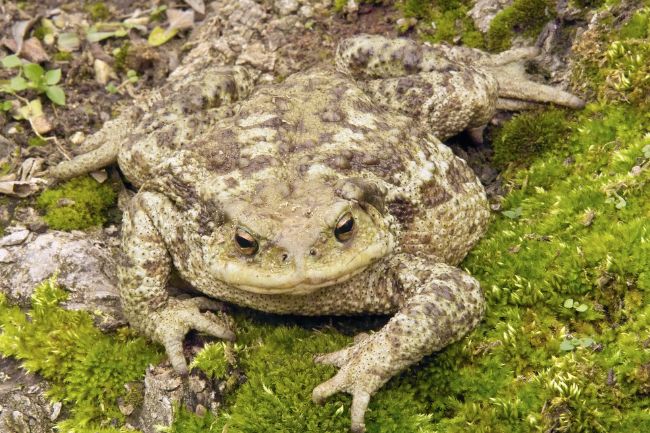
Also read: Frog Hydration: How Do They Drink Water?
Diurnal and Nocturnal Behavior
Both toads and frogs can be active in the day or at night, depending on the species and habitat. Many frogs and toads choose to be more active at night, because temperatures are lower meaning they lose less moisture, and it’s harder for predators to spot them.
Some species will also be active in the day however, as this may be when their prey is most active. Frogs and toads often eat cold-blooded insects that are less likely to be active in the nighttime without the warmth of the sun. However, other prey species, such as molluscs like slugs, may choose to be more active at night, making this an excellent time to hunt for them.
Reproduction
Breeding Behavior
The breeding behaviour of frogs and toads varies a great deal depending on the species. One thing that is common among most species is that frogs and toads tend to lay their eggs in water.
There are some notable species that lay their eggs on leaves, or even carry them around on their backs, but the vast majority will find a suitable pool of water and lay their eggs in there. These eggs will then hatch into tadpoles and later grow into froglets and toadlets, before becoming adults.
Mating behaviour is similarly diverse, however, many frogs and toads use mating calls to attract a mate, with the male using his voice to draw in females. Some will gather in large groups by suitable pools of water, with a chorus of frogs or toads bringing females in to mate. In other species a solitary male will defend a territory and draw females to him with his call.
Egg Clusters
Frog egg clusters
Frog eggs tend to be laid in clusters. How many eggs a frog lays depends on the species, however, many lay large numbers, forming a kind of spawn cloud.
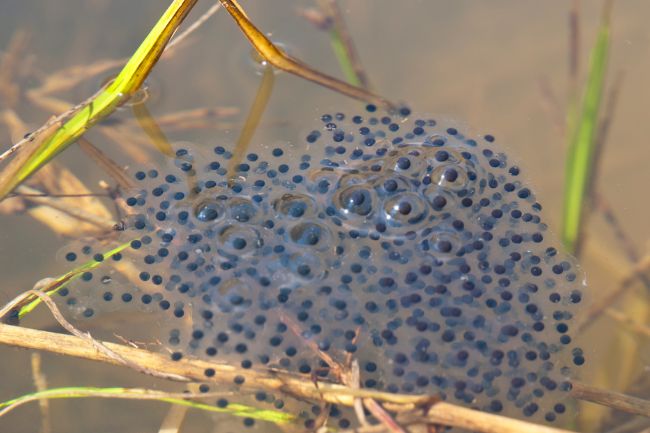
Toad egg strings
Toads on the other hand tend to lay their eggs in strings, which makes them quite distinctive from frog eggs.
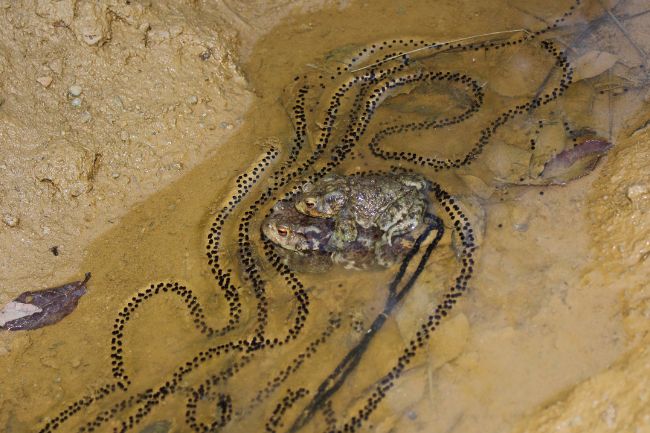
Also read: Lifespan of Wild and Pet Frogs
Calls, Communication of Frogs and Toads
Types of Frog and Toad Calls
The calls of frogs and toads can vary a great deal between species, with some being deep and guttural, others being more of a squeak. Size can have a big impact on the call of a toad or frog, but even small species can be surprisingly loud. There’s no real difference between the calls of toads and frogs, simply because there is so much variation between species.
Frog and Toad Communication
Vocalizations are very important for most frog and toad species, as they play an important part in the mating process. By calling, a male is able to attract a mate, by demonstrating he is fit and healthy.
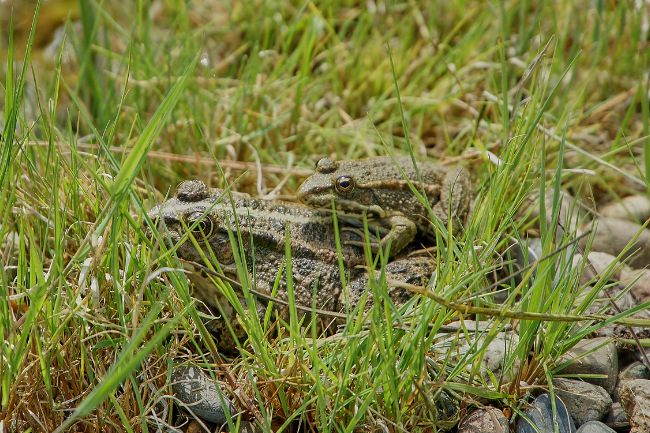
Diet and Feeding Habits
Both frogs and toads are carnivorous. The kinds of prey they tend to hunt usually depends on their size, but can be quite diverse. Frogs and toads will often eat insects, worms and slugs, but can also eat mosquitos, flies, spiders, birds, fish and even mice.
Frogs and toads tend to be ambush hunters, as they don’t tend to be fast enough to chase down their prey. Both tend to have long sticky tongues that they can use to grab prey and pull it back to their mouths.
There are some exceptions to their method of hunting, with aquatic frogs such as African clawed frogs, not having this long sticky tongue, and instead using their claws to grab food and force it into their mouths.
Also read:
Frog Food: Discovering What Wild and Pet Frogs Eat
Which Species of Frogs Eat Fish (Explained)?
| Aspect | Frogs | Toads |
|---|---|---|
| Diet | Carnivorous, eat insects and small prey | Carnivorous, consume insects and invertebrates |
| Hunting Technique | Ambush predators, rely on speed | Wait for prey to come close, then strike |
Common Questions
- What are the main differences between frogs and toads?
There’s no clear answer to this, as toads are a type of frog. However, many species are labeled as toads because of their warty and thicker skin, larger bodies and tendency to walk rather than hop. - How can you tell a frog apart from a toad based on their appearance?
Most toads have much wartier and drier skin than frogs. - Do frogs and toads have different habitats?
Frogs and toads live in many of the same habitats, but toads are often able to spend more time away from water. - Are frogs and toads active during the same time of day?
The time of day that frogs and toads are active tends to depend on the species, but both can be active a great deal at night. - What are the unique reproductive behaviors of frogs and toads?
Reproductive behaviour in frogs and toads varies by species, however, toads tend to lay their spawn in strings whereas frogs lay them in clusters. - How do frog and toad vocalizations differ?
The vocalization of frogs and toads varies a great deal depending on the species, however, there’s no particular difference between frogs and toads. - Are there differences in the diet and feeding habits of frogs and toads?
Both frogs and toads eat a range of animal species, such as insects, worms and slugs. Both can use their long sticky tongues to catch prey.
Conclusion
The line between a frog and a toad is quite blurry, and some species can even be called both. Mostly the word toad tends to be applied to larger or warter frogs, and in particular those that walk rather than hop, but confusingly there are large, warty frogs.
Although there is no hard and fast rule about what is a toad and what is a frog, the words no doubt came into use because the diversity and range of frog species out there meant it felt like a further subdivision would be useful. We certainly can make arguments for what we might call a toad and why, but it seems like not everyone is always playing by the rules.
Whether a toad or a frog, the main thing to remember is that these fascinating species play an important part in many ecosystems, being both predator and prey. Without them we will lose something important, which is why it is vital that we continue to try and protect them, and the places they call home.

